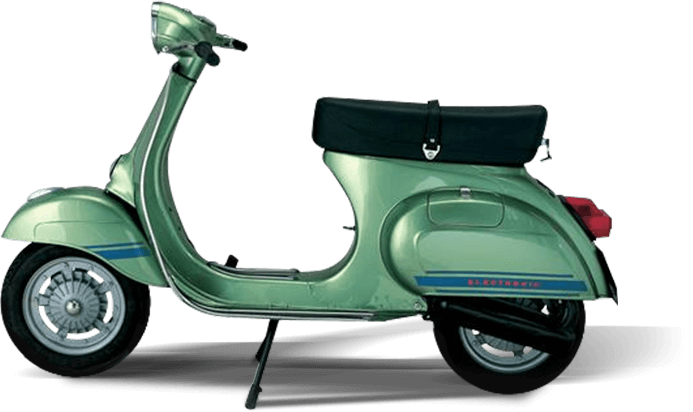-
-

Opportunity
in ChallengesHe decided to serve Italians with a convenient, affordable and classy vehicle that could traverse the damaged roads.
With a clear focus on aesthetics, technology and customer satisfaction, the Vespa MP6 was designed. Upon seeing it for the first time, Enrico Piaggio exclaimed, “Sembra una vespa!” or “It looks like a wasp!”
Thus began the journey of Vespa.
-
Riding into a New Age 1940s Italy saw a new ride on the roads that was superior in aesthetics and technology.1940
Inspired by Aircrafts:
The new design of the headlamps and the metallic silver colour were reminiscent of Piaggio’s aircraft business.
Customer Centric Design:
To make it easy to deal with the frequent puncture after riding on damaged roads, Vespa introduced a spare tyre in its design which eventually became a brand signature.
Comfort for Everyone:
The foot space in front allowed women to ride it comfortably in dresses and skirts. This meant that they could travel without relying on men to drive them.
Soaring Popularity:
It was reported that buying a Vespa would entail a waiting list of 8 months.







-
Riding into the Spotlight Vespa becomes an onscreen and offscreen favourite1950
Hollywood Debut:
The Vespa featured in the highly beloved, The Roman Holiday, almost as a new character bringing the leads together.
Global Appeal:
This cameo in a film made Vespa a global favourite, taking it from Italian streets to the hearts of enthusiasts across the globe.
Cultural Impact:
So charming was the appeal of the Vespa that tourists weren’t hesitant to rent Vespas on their own Roman holidays.






-
Vespa 501960
A Symbol for the New Generation
Giving a face to a shared identity for the youth
New Identity:
The youth was looking for a classy way to rebel against their parents’ post-war ideologies and relate to a lifestyle that matched their ideals.
New Marketing Approach:
The Vespa 50 was positioned as “Young, modern...and without documents.” as the traffic rules of that time allowed it to be ridden without license plates
New Symbol:
Vespa became a symbol of classy irreverence, an icon that represented the new lifestyle that celebrated freedom, individuality and playfulness.






-
Making a Mark Globally Competing in international markets1970
Commissioned for Export:
The Vespa became popular in Japan and the Vespa 125 ET3 remained on sale there till the mid-1990s.
Economic Revival:
Vespa was a key player in reviving the post-war Italian economy. It was now taking it a step ahead by putting Italian products on the world map.
Symbol for the Youth:
Vespa continued to be a youth icon for those who rebelled against established notions of society in their own way, in their own attitude.






-
Style Meets Performance Redesigned aesthetics with powerful technology1980
Sporty Design:
Equipped with a powerful engine, lines, spoiler, windshield and digital tachometer gave the Vespa a sporty appeal.
Eyes on the World:
The new aesthetics were created to compete with the fierce competition in Japanese markets.
Beauty with Power:
The previously “pretty and stylish” Vespa was now seen as a powerful ride with superior technology.







-
Redesigned for the New Generation Style that appeals to the next generation of riders1990
Product of Experience:
Around 50 years of experience in the automobile industry helped to create Vespas that matched the aesthetic and performance expectation of the new riders.
Varied Offerings:
To cater to the diverse needs and appetite of global youth profiles, Vespa models were developed in different specifications.
Green at Heart:
The new engine was designed such that the fuel consumptions were reduced by around 30% and emissions were decreased by 70% approximately.






-
Entering the World of Superlatives Perfect combination of style and speed2000
Product of Experience:
The Vespa GTS 250 IE reinvents itself to become the fastest, most powerful and most high-tech Vespa.
Sporty Appeal:
The design was reminiscent of all the years when the Vespa competed on race tracks, even setting world records.
Flexing the Creative Muscle:
The brand was synthesising the best with its years of experience, market understanding and futuristic vision.






-
Achieving Cult Status From being a brand to a lifestyle to a cult2010
Futuristic Designs:
New, sleek designs combine modern aesthetics with great functionality
Expanding Horizons:
The new models establish Vespa’s relevance in the lifestyle circuit, in moments of fun and excitement in the lives of the customers.
Forming a Shared Identity:
Millennial and Gen Z Vespa riders now identified with a common thirst for exploration, lifestyle and classy irreverence.







-
A Creative Ode to the 60s Reviving the classic style2020
Old in New:
The stylish look of the 60s was rediscovered in the modern set up with superior performance.
Building a Fashion Icon:
The design furthered the brand’s image as not just as an automobile brand but also a fashion icon - a lifestyle in itself.









-
When Legacy meets the Future Celebrating 75 Years of Vespa2021
75 Years Young:
As an important milestone in this journey, the Vespa 75th special edition pays a tribute to the brand’s heritage as well as paves the path towards futuristic mobility.
Extraordinary In Every Sense:
The steel metal body, chrome front tie and the “75” motif on the designs reflect Vespa’s acute attention to design details.













